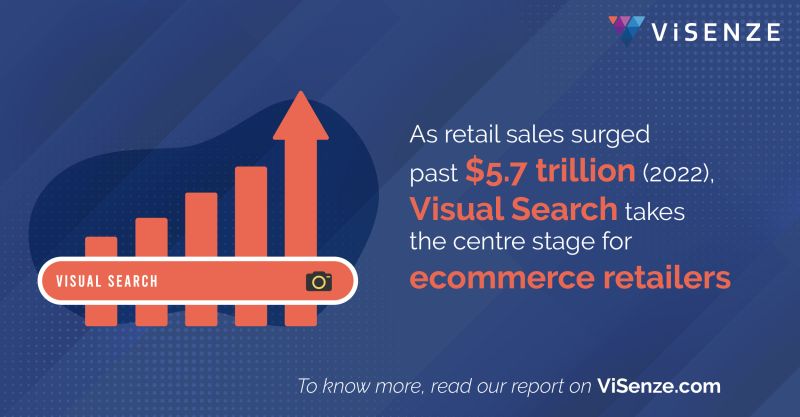
- January 10 2024
How can retailers build ‘search’ to increase conversions?
Imagine that you spot a piece of jewelry, a funky top, or a floral pattern t-shirt, or even a polka-dotted skirt in an offline store. Now, you want to search for the exact product online. How do you describe the details in the search bar? You could try typing some related keywords, but chances are you might not find the exact match.
Wouldn’t it be great if the search bar could understand images? This could help shoppers simply show what they want, helping businesses increase conversions and revenue. According to research from The Intent Lab, 36% of consumers have conducted a visual search.
Visual Search uses advanced computer vision and AI to analyze images shoppers upload.
With visual search, shoppers can snap a picture or upload screenshots of what they want. The technology quickly identifies features like color, pattern, and style, finding visually similar products in no time.
62% of millennials prefer visual search over any other new technology and this makes complete sense as ‘Seeing’ has always been our natural way of searching.
Understanding Consumer Search Behavior
Influence on Online Shopping
Text search requires users to articulate what they’re looking for using specific keywords or phrases. This process can be challenging, especially if they’re unable to accurately describe the item they want. It involves trial and error, sifting through various descriptions, and hoping to stumble upon a matching product.
Visual search, on the other hand, allows consumers to simply show an image of what they desire. This method bypasses the need for precise verbal descriptions and allows users to rely on visual cues.
Consumers rely on visual cues to make informed decisions, often seeking a seamless transition from what they see in their physical environment to online platforms. This behavior underscores the necessity for e-commerce sites to embrace visual search functionalities that mirror real-world experiences.
55% of consumers say visual search contributed to influencing their style and taste.
Importance of Data Analytics
Data analytics in ecommerce allows for the extraction of invaluable insights. By examining search queries, click-through rates, and conversion paths, businesses gain a comprehensive understanding of user preferences and behaviors. For instance, a study by McKinsey notes that companies utilizing advanced analytics witness up to a 126% profit increase over their competitors.
Leveraging AI for Enhanced Search Capabilities
AI keeps enhancing search features, making them stronger. In ecommerce, image search stands out as a powerful tool.
Thanks to better AI, buyers can take a picture of what they want, and then, with personalized suggestions, find great offers. This tech boosts finding products and keeping customers interested, leading to more sales.
In fact, revenues of ecommerce websites that are early adopters of visual search are projected to increase their digital commerce revenue by 30%.
Benefits of AI in Ecommerce Search
AI-driven enhancements in ecommerce search ensure several benefits like accuracy, speed, and relevance.
- Accuracy: AI algorithms analyze vast datasets to comprehend user preferences, enabling precise product recommendations.
- Speed: AI-driven search processes data swiftly, providing near-instantaneous results.
- Relevance: By understanding user behavior, AI refines search results, ensuring relevance.

(source)
Implementing Visual Search Technology to Increase Conversions
The decision to implement visual search should stem from understanding the potential impact on user experience and sales.
The benefits are compelling. Here are some other ways your ecommerce business will get a boost if you decide to implement visual search:
- Seamless Product Discovery: By analyzing user-uploaded images, it presents visually akin products, broadening options beyond text-based searches, and introducing users to items that might have eluded them via traditional search methods.
- Inspiration & Style Exploration: This tool encourages style experimentation, allowing users to mix and match products while staying abreast of trends.
- Effortless Visual Bookmarking: Acting as a user-centric bookmarking tool, visual search allows users to save products of interest for future reference. This eliminates the hassle of manual searches, enabling easy access to previously liked items.
- AR-Enabled Try-On Experience: Integration of AR technology enriches the shopping journey, enabling virtual try-ons for clothing, eyewear, or cosmetics. This feature minimizes uncertainties associated with online shopping, boosting user confidence.
Ultimately, the decision to implement visual search should be based on aligning with customer preferences and enhancing the overall shopping experience, which data suggests can have a significant positive impact on sales and customer satisfaction.
Leading Brands Embracing Visual Search
Meesho offers a wide variety of products at competitive prices for its customers. A lot of its customers are new to online shopping, especially from smaller cities in India. Meesho’s app is super popular, with over 500 million downloads.
Meesho wanted to make it easier for them to search, especially for young people who follow celebs and want to find similar styles effortlessly.
ViSenze enables Meesho to do exactly this.
Over the last couple of years, Meesho’s customers have done almost a billion visual searches annually. By ensuring that Meesho customers find what they want faster, AI-powered Smart Visual Search helped Meesho unlock more revenue.

(source)
Natural Language Processing for Better Search Results
Interpreting User Queries
NLP enables e-commerce platforms to decipher and process user queries in a more nuanced manner. By analyzing language patterns, contextual cues, and semantics, NLP understands the intent behind user queries. For instance, when a user searches for “women’s running shoes under $50,” NLP comprehends the specific criteria and retrieves relevant results.
Examples of NLP Improving Search Relevancy
An example showcasing NLP’s impact on search relevancy is evident in how Amazon’s recommendation system operates. Through NLP-powered algorithms, Amazon interprets user queries and past behavior to generate personalized recommendations. This approach significantly boosts relevancy, contributing to approximately 35% of Amazon’s sales.
Role of AI-Powered Tagging
Tags play a crucial role in aiding shoppers to discover products effortlessly.
Ecommerce stores can enhance online product information by using AI-powered tagging. With detailed descriptions to help shoppers navigate easily, they simplify the shopping experience by ensuring all your products are readily accessible and purchasable.
Collaborating with intelligent search, smart tagging streamlines the buying process for customers.
Personalization: Tailoring Search to Individual Users
Importance of Personalized Search Experiences
According to a report by Segment, 49% of consumers have made impulse purchases after receiving a personalized recommendation from AI. This emphasizes the crucial role personalized search plays in creating a compelling and engaging shopping journey, fostering customer loyalty and satisfaction.
Techniques for Creating Personalized Search Results
- Behavioral Analysis: Ecommerce platforms track user behavior, including search history, browsing patterns, and previous purchases, to understand individual preferences. For instance, Amazon’s recommendation system analyzes browsing history and purchase behavior to suggest products aligned with users’ interests.
- Machine Learning Algorithms: Employing machine learning algorithms enables platforms to predict user preferences based on historical data. By continuously learning from user interactions, these algorithms refine and personalize search results. For example, Netflix uses machine learning to suggest personalized movies or show recommendations based on viewing history and preferences.
- Preference-based Filters: Offering users the ability to customize search filters based on their preferences, such as size, color, price range, and brand, enhances the personalization aspect. This empowers users to refine search results according to their specific criteria, ensuring relevant outcomes.
- User Profiling: Creating detailed user profiles by gathering demographic information and user preferences helps in tailoring search results. For instance, Spotify curates personalized playlists based on user-defined preferences, music tastes, and listening habits.
Optimizing Search for Mobile Users
Significance of Mobile Optimization in Retail Landscape
Mobile optimization is key in today’s retail landscape due to the exponential growth of mobile usage in shopping. Statista reports that mobile commerce is expected to account for 60% of total e-commerce sales by 2023 emphasizing the dominance of mobile devices in online shopping. Mobile optimization is important in retaining users and preventing bounce rates, significantly impacting conversion rates and revenue.
Best Practices for Mobile Search Optimization
- Responsive Design: Ensuring the website layout adapts seamlessly to different mobile devices and screen sizes is crucial.
- Fast Loading Speed: Optimizing images, leveraging browser caching, and minimizing unnecessary scripts are essential to improve loading times.
- Simplified Navigation: Intuitive and straightforward navigation is key for mobile users. Clear and concise menu structures and prominent search bars enhance user experience.
- Image and Voice Search Integration: It is all about convenience for customers today. Integrating image and voice search capabilities enhances the shopping experience.
User-friendly Interface and Navigation
Design Elements Enhancing the Search Experience
- Predictive Text and Auto Suggestions: Implementing predictive text and auto-suggestions in the search bar enhances user experience.
- Visual Feedback: Incorporating visual cues like loading animations or highlighting selected filters provides instant feedback to users, aiding in smoother navigation. This enhances user engagement and satisfaction.
- Filtering and Sorting Options: Offering robust filtering and sorting options simplifies the search process.
- Minimalistic Design: A clutter-free and intuitive layout streamline the search experience. Research by Google suggests that users judge a website’s credibility within 50 milliseconds, emphasizing the importance of a clean design.
Examples of Intuitive Search Interfaces
- Pinterest’s Visual Discovery: Pinterest’s visual search allows users to click on items within images to find similar products, simplifying the search process and enhancing user engagement.
- Google Images: Google’s visual search capabilities enable users to upload images or use the camera to search for visually similar items. This intuitive interface facilitates easy exploration of products.
- Sephora’s Visual Artist: Sephora’s Visual Artist utilizes augmented reality to allow users to virtually try on makeup, providing an immersive and interactive search experience.
- IKEA Place: IKEA’s app integrates AR to enable users to virtually place furniture in their space, enhancing the decision-making process and providing a unique search experience.
Increase Conversions with Real-time Analytics and Feedback Loops
Utilizing Real-time Analytics for Search Algorithm Refinement
Real-time analytics are pivotal in refining search algorithms in ecommerce. By analyzing user interactions, click-through rates, and search patterns instantaneously, ecommerce platforms can swiftly adapt and optimize their search algorithms.
A study by McKinsey suggests that companies leveraging real-time analytics achieve a competitive advantage in terms of profit margins. Real-time data empowers ecommerce platforms to swiftly identify trends, understand user behavior, and adjust algorithms to provide more accurate and relevant search results.
Incorporating User Feedback for Continuous Improvement
User feedback serves as a cornerstone for continuous improvement in visual search. Platforms that actively solicit and integrate user feedback witness notable enhancements in their search functionalities. For example, Amazon encourages users to rate and review product searches, contributing significantly to algorithm adjustments and product recommendations.
Direct user input, such as ratings, reviews, and search queries, allows e-commerce platforms to fine-tune their algorithms, ensuring that search results align more closely with user preferences.
The Future of E-commerce is Personalized
The implementation of visual search, AI-driven algorithms, and real-time analytics not only improves user experiences but also increases conversion rates and customer satisfaction.
The future of search in e-commerce is poised for continuous evolution, driven by technological advancements and shifting consumer behaviors. Visual search, powered by AI and machine learning, will increasingly dominate the e-commerce landscape.
Get in touch with us now at Visenze and get to know the best solutions for product discovery.

